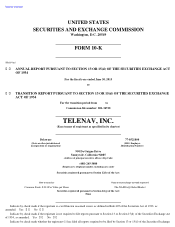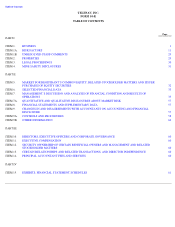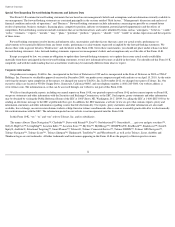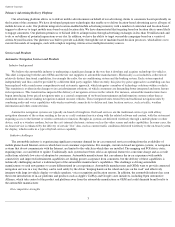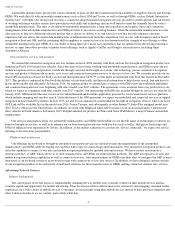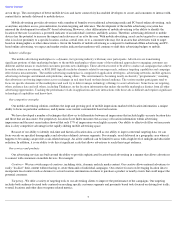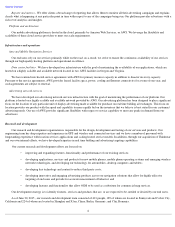TeleNav 2015 Annual Report Download - page 8
Download and view the complete annual report
Please find page 8 of the 2015 TeleNav annual report below. You can navigate through the pages in the report by either clicking on the pages listed below, or by using the keyword search tool below to find specific information within the annual report.
Table of Contents
Telenav's Advertising Delivery Platform
Our advertising platform allows us to deliver mobile advertisements on behalf of our advertising clients to consumers based specifically on
the location of the consumer. We have developed proprietary technologies that enable us to deliver location-based advertising across all types of
mobile devices at scale. Our platform integrates location-enabled mobile advertising inventory with a number of contextual and location-based
triggers to allow us to target mobile users based on rich location data. We have demonstrated that targeting based on location data is more likely
to engage consumers. Our platform permits us to bid and deliver ad impressions through advertising exchanges in less than 30 milliseconds and
to do so on billions of potential impressions every day. In addition, we have the ability to target our mobile campaigns based on a variety of
criteria beyond location. Our platform was built to provide scalability through the use of machine-based decision processes, which allows us to
execute thousands of campaigns, each with complex targeting criteria across multiple inventory sources.
Services and Products
Automotive Navigation Services and Products
Industry background
We believe the automobile industry is undergoing a significant change in the way that it develops and acquires technology for vehicles.
This shift is impacting both the auto OEMs and the tier one suppliers to automobile manufacturers. Historically a car included a collection of
relatively distinct functional capabilities, for example the radio, the air conditioning system and the braking system. Each system operated
independently and thus could be provided by a different third party supplier. More recently, this piece-by-piece approach to assembling cars has
been replaced with a much more comprehensive and systematic approach, which integrates a number of technology solutions within a vehicle.
This transition is evident in the changes to in-car infotainment solutions, of which consumers are demanding better integrated and more feature
rich experiences. This transition has impacted the delivery of navigation services in the vehicle. For instance, automobile manufacturers have
begun introducing lower priced navigation units as a central component of on-board entertainment and information systems rather than as
standalone units and are making navigation standard on more vehicles. These integrated units extend beyond traditional navigation units by
combining audio and voice capabilities with wireless network connectivity to deliver real time location services, such as traffic, weather
information and other connected data.
Automotive navigation systems are typically on-board or brought-in. On-board services are the traditional service type with all key
navigation elements of the system residing in the car as a self-contained service along with the related software and content, with the system not
requiring access to the Internet or wireless networks to function. Brought-in systems are delivered wirelessly through a mobile phone or other
device, such as a wireless modem, but use the car's internal electronic systems such as the video screen and audio capabilities. In some cases, the
on-board service is enhanced by the delivery of certain “live” data, such as current traffic conditions delivered wirelessly to the on-board system
for display, which results in a type of hybrid service capability.
Industry challenges
The automobile industry is experiencing significant consumer demand for in-car connected services resulting from the availability of
mobile phone-based Internet services which have reset consumer expectations. For example, current on-board navigation systems, or navigation
systems that do not communicate with the Internet, are limited to the vehicle in which they are installed. The mapping and POI data is static,
requiring time, cost and effort to update. Traditionally such systems have been sold as an optional feature for a one-time charge and as a result
suffer from relatively low rates of adoption by consumers. Automobile manufacturers that can enhance the in-car experience with mobile
connectivity and improved infotainment capabilities are finding greater acceptance from consumers, but the delivery of these capabilities is
technically challenging and not a traditional part of the automobile manufacturer's capabilities. This challenge is driving automobile
manufacturers to seek new partners to create differentiated in-car experiences. Automobile manufacturers and OEMs want to provide connected
navigation services in a way that they can be used safely by the driver “keeping hands on the wheel and eyes on the road” and effectively
integrate with large in-vehicle display or vehicle speakers, voice recognition and location sensors. In addition, the automobile industry has seen
the recent introduction of in-car platforms and products such as Apple's CarPlay and Google's auto initiatives, including Open Automotive
Alliance, which take control of the product and platform away from the automobile manufacturer or OEM and could diminish brand loyalty to
the automobile manufacturer.
Our competitive strengths
3


